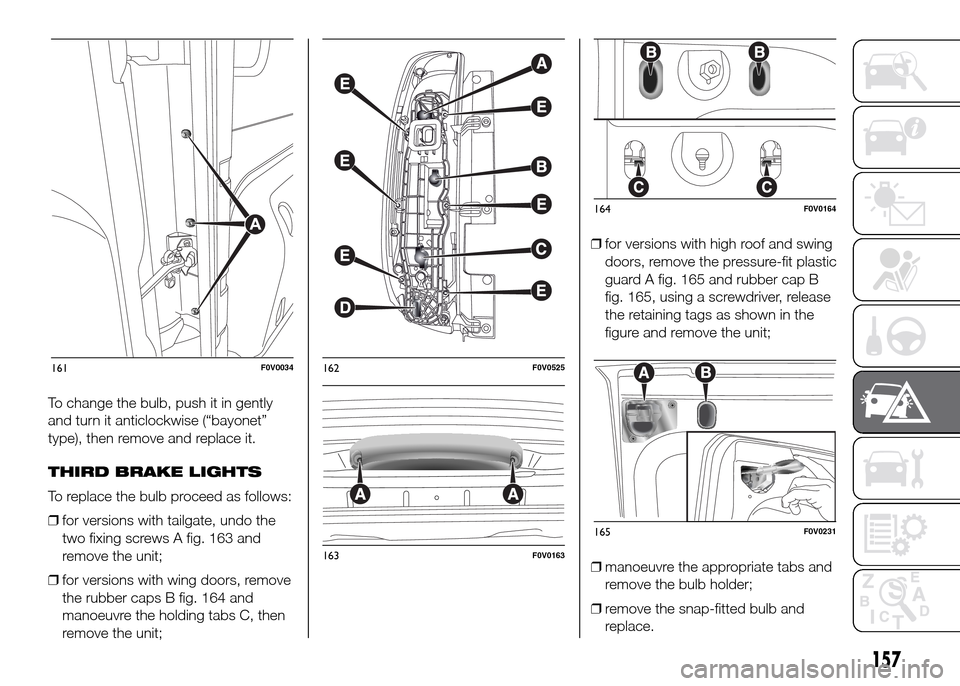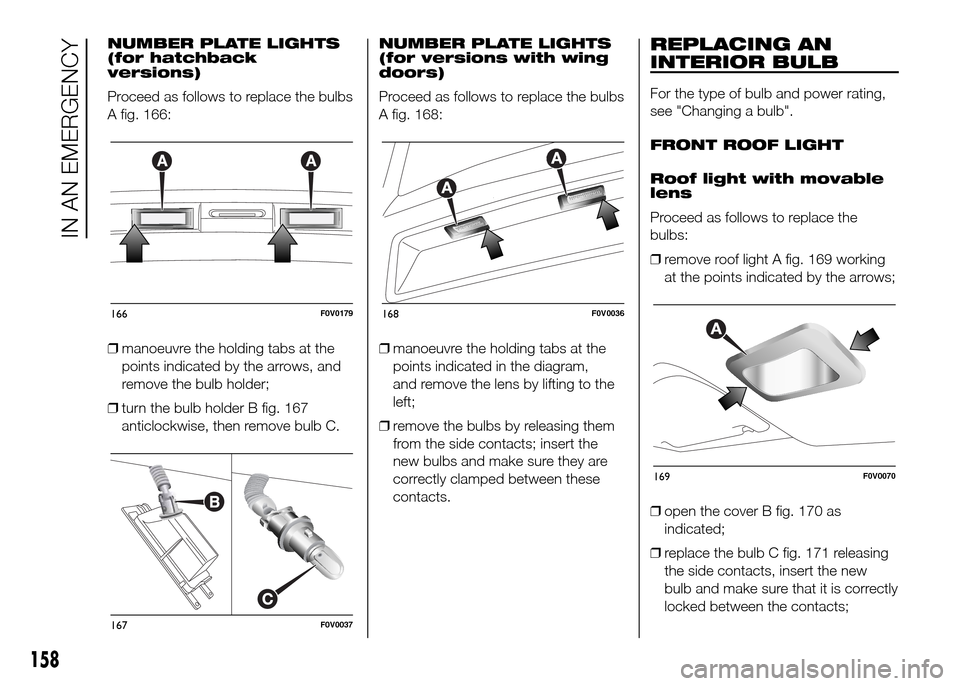2016 FIAT DOBLO PANORAMA ABS
[x] Cancel search: ABSPage 153 of 323

TOWING TRAILERS
IMPORTANT
The vehicle must be equipped with a
type-approved tow hook and adequate
electrical system to tow trailers.
Installation should be carried out by
specialised personnel who will issue the
required papers for travelling on roads.
Install any specific and/or additional
door mirrors as specified by the
Highway Code.
Remember that when towing a trailer,
steep hills are harder to climb, braking
spaces increase and overtaking takes
longer depending on the overall weight.
Engage a low gear when driving
downhill, rather than constantly using
the brake.
The weight of the trailer on the vehicle
tow hook will reduce the loading
capacity of the vehicle by the same
amount.
To make sure that the maximum
towable weight is not exceeded (given
in the vehicle registration document)
account should be taken of the fully
laden trailer, including accessories and
luggage.Do not exceed the speed limits specific
to each country you are driving in, in
the case of vehicles towing trailers.
In any case, the top speed must not
exceed 80 km/h.
99) 100)
WARNING
99) The ABS device with which the
vehicle is equipped will not
control the braking system of the
trailer. Particular caution is
required on slippery roads.
100) Never modify the braking
system of the vehicle to control
the trailer brake. The trailer
braking system must be fully
independent from the hydraulic
system of the vehicle.
SNOW TYRES
Fiat Dealerships will be happy to
provide advice concerning the most
suitable type of tyres for the customer's
requirements.
For the type of tyre to be used, inflation
pressures and the specifications of
snow tyres, follow the instructions given
in the "Wheels" paragraph of the
"Technical specifications" section.
The winter features of these tyres are
reduced considerably when the tread
depth is below 4 mm. Replace them in
this case.
Due to snow tyre characteristics, under
normal conditions of use or on long
motorway journeys, the performance of
these tyres is lower than that of
standard tyres. Limit performance
according to the use for which they
were approved.
IMPORTANT When using snow tyres
with a maximum speed index below the
one that can be reached by the vehicle
(increased by 5%), place a notice in
the passenger compartment, plainly in
view, which states the maximum speed
allowed by the snow tyres (as per EC
Directive).
149
Page 161 of 323

To change the bulb, push it in gently
and turn it anticlockwise (“bayonet”
type), then remove and replace it.
THIRD BRAKE LIGHTS
To replace the bulb proceed as follows:
❒for versions with tailgate, undo the
two fixing screws A fig. 163 and
remove the unit;
❒for versions with wing doors, remove
the rubber caps B fig. 164 and
manoeuvre the holding tabs C, then
remove the unit;❒for versions with high roof and swing
doors, remove the pressure-fit plastic
guard A fig. 165 and rubber cap B
fig. 165, using a screwdriver, release
the retaining tags as shown in the
figure and remove the unit;
❒manoeuvre the appropriate tabs and
remove the bulb holder;
❒remove the snap-fitted bulb and
replace.
161F0V0034162F0V0525
163F0V0163
164F0V0164
165F0V0231
157
Page 162 of 323

NUMBER PLATE LIGHTS
(for hatchback
versions)
Proceed as follows to replace the bulbs
A fig. 166:
❒manoeuvre the holding tabs at the
points indicated by the arrows, and
remove the bulb holder;
❒turn the bulb holder B fig. 167
anticlockwise, then remove bulb C.NUMBER PLATE LIGHTS
(for versions with wing
doors)
Proceed as follows to replace the bulbs
A fig. 168:
❒manoeuvre the holding tabs at the
points indicated in the diagram,
and remove the lens by lifting to the
left;
❒remove the bulbs by releasing them
from the side contacts; insert the
new bulbs and make sure they are
correctly clamped between these
contacts.REPLACING AN
INTERIOR BULB
For the type of bulb and power rating,
see "Changing a bulb".
FRONT ROOF LIGHT
Roof light with movable
lens
Proceed as follows to replace the
bulbs:
❒remove roof light A fig. 169 working
at the points indicated by the arrows;
❒open the cover B fig. 170 as
indicated;
❒replace the bulb C fig. 171 releasing
the side contacts, insert the new
bulb and make sure that it is correctly
locked between the contacts;
166F0V0179
167F0V0037
168F0V0036
169F0V0070
158
IN AN EMERGENCY
Page 201 of 323

The level may exceed the MAX mark
when the oil is hot.
If topping up is required, make sure the
oil you use has the same specifications
as that already in the system.
132)
4)
35)
WARNING
126) Never smoke while working in
the engine compartment: gas
and flammable vapours may be
present, with the risk of fire.
127) When the engine is hot, take
care when working inside the
engine compartment to avoid
burns. Remember that when the
engine is hot, the fan may
operate: danger of injury. Scarves,
ties and other loose clothing may
be pulled by moving parts.128) The cooling system is
pressurised. If necessary, only
replace the cap with another
original one or the operation of
the system may be adversely
affected. Do not remove the cap
from the reservoir when the
engine is hot: danger of scalding.
129) Do not travel with the
windscreen washer fluid reservoir
empty: the windscreen washer
is essential for improving visibility.
Some commercial windscreen
washer additives are flammable.
The engine compartment contains
hot parts which could cause a
fire if they come into contact with
these additives.
130) Brake fluid is poisonous and
highly corrosive. In the event of
accidental contact, immediately
wash the affected parts with
water and mild soap. Then rinse
thoroughly. Consult a doctor
immediately if you swallow the
fluid.
131) The symbol
on the container
indicates a synthetic brake fluid,
which is different from a mineral
fluid. Using a mineral-type fluid
will damage the special rubber
seals of the braking system
beyond repair.
197
Use the brake fluid shown in the "Fluids
and lubricants" table (see "Technical
Specifications").
NB Carefully clean the reservoir cap E
and surrounding surfaces.
Take great care to ensure that
impurities do not enter the reservoir
when the cap is opened.
For topping-up, always use a funnel
with integrated filter with mesh equal to
or lower than 0.12 mm.
IMPORTANT Brake fluid absorbs
moisture. For this reason, if the vehicle
is mainly used in areas with a high
degree of atmospheric humidity, the
fluid should be replaced at more
frequent intervals than specified in the
“Scheduled Servicing Plan”.
34)
130) 131)
POWER STEERING FLUID
Check that the oil level with the vehicle
on flat ground and the engine cold is
between the MIN and MAX marks
on the reservoir body G fig. 211 - fig.
212 - fig. 213 - fig. 214 - fig. 215 - fig.
216 - fig. 217.
Page 204 of 323

The battery is also more prone to the
risk of freezing (already at temperatures
of -10°C). Refer to the paragraph
"Vehicle inactivity" in "Starting and
driving" if the vehicle is left parked for a
long time.
If, after buying the vehicle, you want to
install electric accessories which require
permanent electric supply (alarm, etc.)
contact a Fiat Dealership whose
qualified personnel, in addition to
suggesting the most suitable devices
from the Lineaccessori Fiat, will
evaluate the overall electric absorption,
checking whether the vehicle's
electrical system is capable of
withstanding the load required, or
whether it should be integrated with a
more powerful battery.
Since some of these devices continue
to consume electricity even when
the engine is off, they gradually run
down the battery.
WARNING
133) Battery fluid is poisonous and
corrosive. Avoid contact with
skin and eyes. Keep naked flames
or possible sources of sparks
away from the battery: risk
of explosion or fire.
134) Using the battery when the fluid
is too low can damage it
irreparably and generate a risk of
explosion.
135) When performing any operation
on the battery or near it, always
protect your eyes with special
goggles.
IMPORTANT
37) Incorrect assembly of electrical
and electronic devices may cause
severe damage to your vehicle.
Contact a Fiat Dealership if you
want to install accessories
(alarms, radiophone, etc.): they
will suggest the most suitable
devices and advise you if a higher
capacity battery needs to be
installed.
38) If the vehicle needs to be off the
road for a long period under
conditions of intense cold, remove
the battery and take it to a
heated location, otherwise it may
freeze.
200
SERVICING AND MAINTENANCE
Page 205 of 323

IMPORTANT
5) Batteries contain substances
which are very dangerous for the
environment. To replace your
battery, we recommend
contacting your Fiat Dealership to
dispose of your old battery in full
respect of the environment and in
compliance with all applicable
laws and regulations.
BATTERY
RECHARGING
IMPORTANT The battery recharging
procedure is given as information only.
This operation should be performed
at a Fiat Dealership.
Charging should be slow at a low
ampere rating for approximately 24
hours. Charging for a long time may
damage the battery.
To recharge, proceed as follows:
IN THE ABSENCE OF THE
START&STOP SYSTEM
❒disconnect the terminal from the
negative battery pole;
❒connect the charger cables to the
battery terminals, observing the
poles;
❒turn on the charger;
❒when you have finished, turn the
charger off before disconnecting
it from the battery;
❒reconnect the negative battery
terminal.WITH START&STOP
SYSTEM
Versions with dummy pole fig. 218
❒disconnect the quick release negative
terminal A from the dummy negative
terminal B; this is because a battery
status monitoring sensor D is fitted
on the negative battery terminal
C and should never be disconnected
except for when the battery is
actually replaced;
❒connect the positive cable of the
charger to the positive pole of the
battery and the negative cable to the
dummy negative terminal B;
❒turn on the charger;
❒after the recharge, turn the charger
off before disconnecting it from the
battery;
218F0V0381
201
Page 226 of 323

SUSPENSION
Versions Front Rear
Front
independent wheel MacPherson typeMulti-link independent, coil springs,
telescopic shock absorbers and anti-roll bar
(according to version) Rear
222
TECHNICAL SPECIFICATIONS
Page 268 of 323

SUPPLIES
1.4 1.4 T-JETPrescribed fuels and
original lubricants
Fuel tank: 60 litres 60Unleaded petrol not less than
95 RON (EN 228
specification) including a reserve of: 8–10 litres 8-10
Engine cooling system: 5 litres 5.8 litresMixture of demineralised
water and 50% PARAFLU
UP
(***)
Engine sump: 2.35 litres/2kg 2.1kg
SELENIA K P.E.
Engine sump and filter: 2.7 litres / 2.3 kg 2.45 kg
Gearbox casing/differential: 1.76 litres / 1.5 kg 1.5 kgTUTELA TRANSMISSION
GEARFORCE
Hydraulic brake circuit with
ABS anti-lock device:0.450 kg 0.450 kg TUTELA TOP 4
Hydraulic power steering: 0.900 kg 0.900 kgTUTELA TRANSMISSION
GI/E
Windscreen / rear window
washer fluid reservoir (litres):2,2 (*)
/6(**)litres2,2 (*)/6(**)litres
Mixture of water and
TUTELA PROFESSIONAL
SC35
(***) When the vehicle is used in particularly harsh weather conditions, we recommend using a 60-40 mixture of PARAFLUUPand demineralised water.
(*) For Doblò versions without headlamp washers.
(**) For Doblò/Doblò Combi/Doblò Cargo versions with headlamp washers.
264
TECHNICAL SPECIFICATIONS